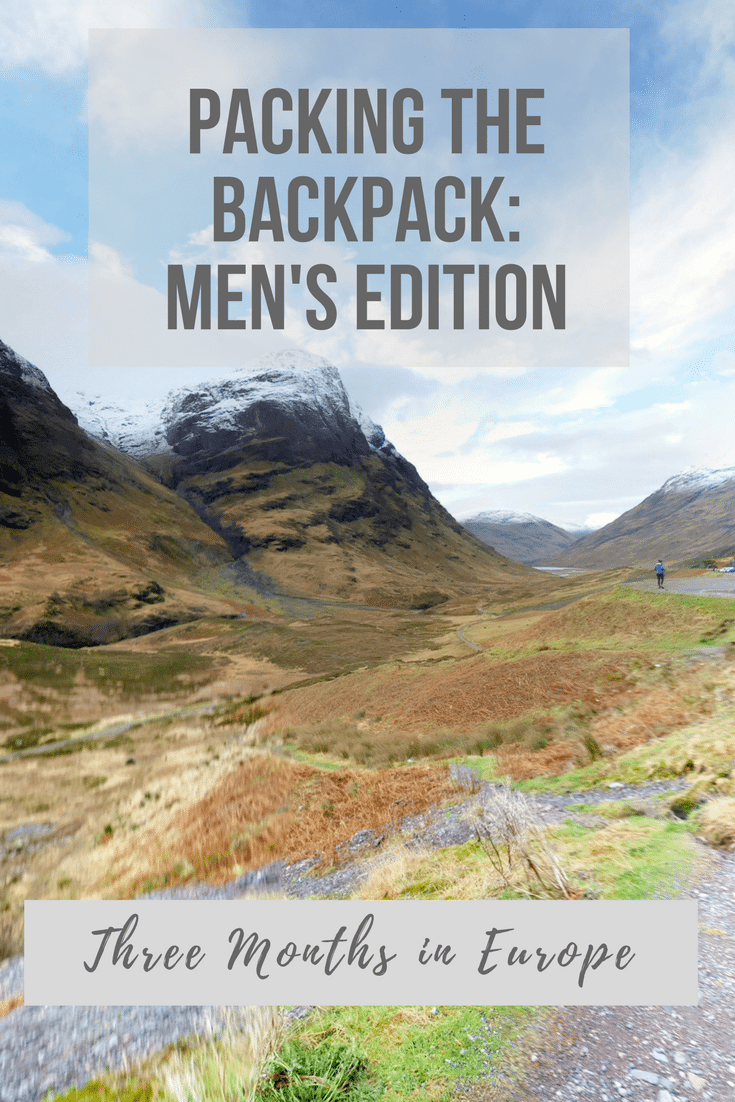Today my husband Daniel is sharing his first ever guest post on the blog! In this post, he shares his perspective on backpack packing tips and his packing list from our European adventure. I shared my personal packing list from this trip a couple of months ago, but this post offers a lot more packing strategy tips, and the packing list is geared toward men. I know I don’t have many (if any) readers who are men, but I’m hoping y’all can share it with your friends/boyfriends/husbands who are packing for a backpacking trip, and I think that anyone can use most of Daniel’s packing tips. This post is full of great details and recommendations, so I know it would be the perfect guide for a man (or even woman) packing for an extended trip!
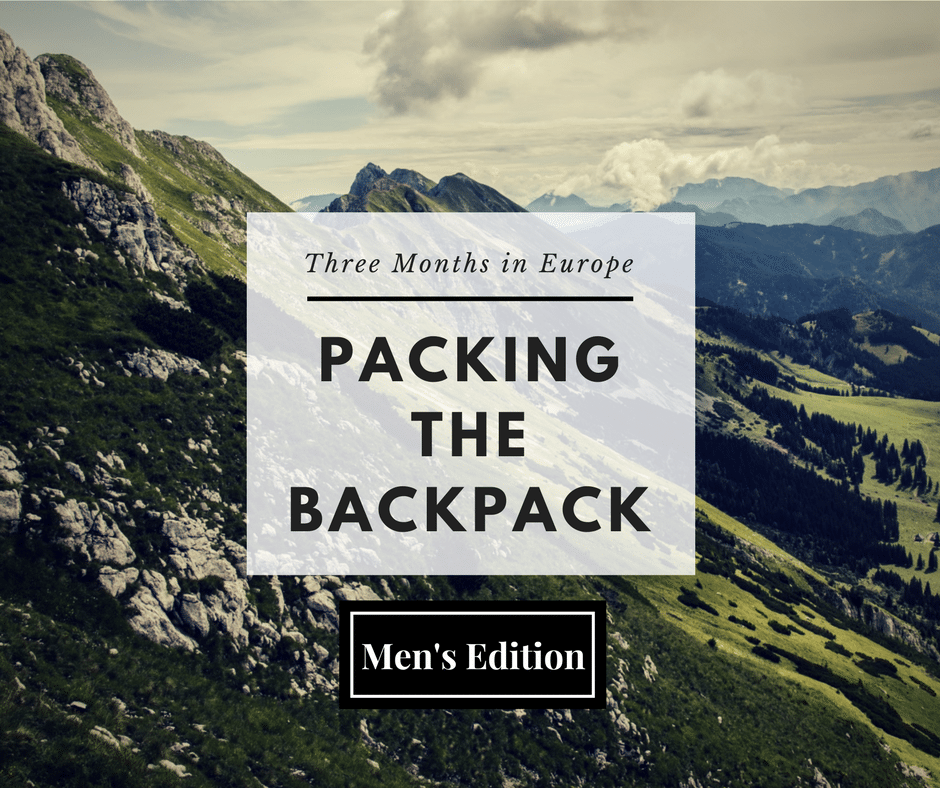 Howdy! I’m Emily’s husband Daniel, and this is my first guest post at Everyday Accounts. If you’ve read Emily’s blog before, you’ll know that last year we spent 2.5 months backpacking through 7 countries in Europe. A few months ago, Emily wrote about her packing strategy, and in this post I’m going to do the same.
Howdy! I’m Emily’s husband Daniel, and this is my first guest post at Everyday Accounts. If you’ve read Emily’s blog before, you’ll know that last year we spent 2.5 months backpacking through 7 countries in Europe. A few months ago, Emily wrote about her packing strategy, and in this post I’m going to do the same.
One of our biggest concerns before the trip was how to pack. Months before we left, we started to think about our backpacks and what kind of clothing and accessories we would need to bring with us. We had traveled internationally before, but never for such a long time and never with such little space to pack in. In the paragraphs below I’ll discuss the planning strategy for my backpack and packing list, go over the list of items that remained in the backpack by the end of the trip, and then talk about what I’d do differently.
This post contains some Amazon affiliate links, meaning if you click on the link, I receive a small percentage of the sale, but the price doesn’t change for you.
The Backpack
I started doing some long-distance hiking in 2014, so I was already familiar with the different brands and features available in hiking backpacks. Travel backpacks are different than hiking backpacks, however, so I still had to do some research. These backpacks have features that make them better suited for cities and trains than for forests and mountains.
After doing a lot of research, I settled on the Osprey Farpoint 55 for my pack:
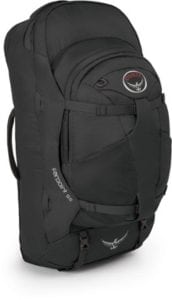
Pretty photo from REI
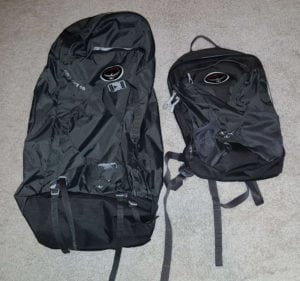
Less pretty photo of my actual backpack
- Stow away straps
- The shoulder straps can be tucked away so that they are less likely to cause trouble during transit (especially important for checking on an airplane).
- Front zipper access to main compartment
- This allows the packs to be accessed and secured like a suitcase. The main compartment on most hiking backpacks, in contrast, is accessed from the top, with a cinch cord to close the opening.
- Internal organization
- In most hiking backpacks, the main compartment is just an empty space. The Farpoint offers two mesh zippered pockets and internal straps to keep your stuff organized and attached to the inside of the pack.
- Sturdy side handles
- The Farpoint includes a strong, comfortable handle on the side that allows the pack to be carried by hand like a suitcase when the shoulder straps are packed away.
- Detachable daypack
- Not all packs offer this, but many do. If yours doesn’t come with one, you’ll almost certainly want to bring your own bag to use as a daypack. The Farpoint’s daypack isn’t perfect, but it does come with a laptop sleeve which was very useful.
- Sidenote: When my pack was full, the daypack on the Farpoint did not work well attached to the back. It made the pack very large and clumsy. Thankfully, you can wear the daypack from the front and attach it to the main pack’s shoulder straps. This method made it much easier for long walks, even if I looked a bit stupid.
Planning Your Clothing
The backpack was a major decision, but almost more daunting was figuring out what would go in it. I was mostly concerned about clothing, as everything else was largely dictated by necessity. Later in the post I’ll detail the actual items that I packed, but first I’ll discuss strategy and planning. Here are some questions that I went through when deciding what clothing to bring:
- What will the weather be like?
- We knew that most of our trip was going to be in the dead of winter (January – February). We assumed that we would encounter cold, snow, and rain.
- What activities will I be be doing?
- Some activities require specific kinds of clothing – exercise, hiking, skiing, etc. We knew that we would need room in our packs for warm clothing, and that winter provides fewer opportunities for outdoor activities. We decided that we would pack for a lot of walking, but not for exercising or adventuring.
- How do I want to look?
- Some folks don’t mind if their outfit screams “tourist!”, and will travel in tennis shoes and zip off hiking pants. That’s totally fine, but I wanted to blend in and look decently well-dressed.
In addition to the questions above, I was also considering:
- Washing
- We tried to plan our trip with access to laundry in mind. Still, I wanted to make sure that my outfits could last a while, with items that could be re-worn and which could be washed and dried quickly. I tried to opt for synthetic material or smartwool wherever possible.
- Packability
- I tried to find clothing that would take as little room as possible. This isn’t a huge deal for t-shirts and underwear, but for sweaters, jackets, and pants, it’s really important to consider the weight and size.
My Packing List – Clothing
I’m not a very stylish dresser, but I wanted to at least look semi well-dressed on this trip. My goal was to be dressed casually but smartly enough to be able to be mistaken for a local (when not wearing the backpack, of course – and it did happen a couple of times!). I tried to aim for darker, solid colors – my jacket was black, and both my fleece and my sweater were dark grey. My jeans had a somewhat dark color.
One major exception to my dark color goal was my Baylor beanie with bright gold stripes, which I proudly wore in the colder weather. The beanie showed off my Baylor pride but also made it easy for Emily to find me in a crowd.
Below I’ll list out exactly what items of clothing I brought on the trip. These are the items that ended up in my pack or on my body when we landed in Austin at the end of the trip.
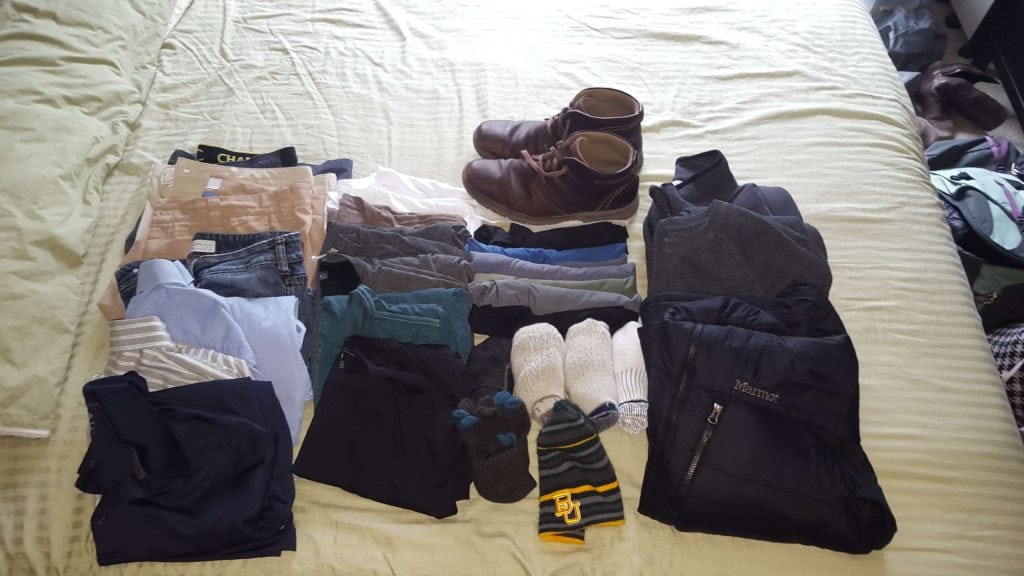
- Shoes – Clarks Chukka Boots
- Finding the right shoe was difficult. I needed shoes that would:
- be comfortable to walk in for hours at a time
- be durable enough to withstand nearly 3 months of intense daily use
- look respectable enough in a nice outfit
- The link above is the closest I could find to what my boots were. My feet did get a little wet on some of the rainy days, so you might consider spending more for a waterproof pair if that’s a concern.
- Finding the right shoe was difficult. I needed shoes that would:
- Undergarments
- Socks (4 pairs)
- I brought 4 pairs of high-quality hiking socks. I wanted socks that would last the whole trip and that could be re-worn 2 or 3 times without losing shape or starting to smell.
- I made sure that at least one pair of the socks would look okay with khakis.
- I can’t recommend Darn Tough socks enough – comfortable, durable, and there is a lifetime warranty.
- Underwear – ExOfficio Men’s Give-N-Go Boxer Brief (6 pairs)
- I started wearing ExOfficio’s after my first Appalachian Trail section hike in 2014, and I haven’t looked back. They are superbly comfortable, don’t lose their shape after days of use (I only re-wear them when hiking, ok), they are easy to wash in a sink, and they dry incredibly quickly. Seriously, they’re probably made from unicorn hair or something.
- Some folks will tell you to bring just 2 pairs – one to wear while the other is drying. Only do this if you’re prepared to wash underwear in the sink every night.
- Undershirts (2)
- I brought 2 synthetic undershirts that could be re-worn if needed.
- Socks (4 pairs)
- Shirts
- Button up shirts (2)
- I brought two button-up shirts that could be worn out to dinner or any other time I needed to look nice.
- Try to bring wrinkle resistant shirts made of synthetic material (I didn’t but wish I had).
- Polo (1)
- This synthetic polo from Target is unbelievably comfortable. I just bought a second one the other day, in fact. It’s great for travel because it can be re-worn multiple times and it packs small.
- T-shirts – short-sleeve (4) and long-sleeve (1)
- Layering during winter is important, and these were the lowest level of my layers. Some of the shirts were also just for sleeping.
- My favorite was the long-sleeve t-shirt. It was a Terramar Dri-Release shirt, and I still wear it often.
- Button up shirts (2)
- Shorts (2)
- I brought a pair of gym shorts and a pair of light-weight khaki-colored shorts. These were mainly for just being comfortable when back at our hotel, but also for wearing while doing laundry.
- Pants
- Jeans (1 pair)
- Jeans are pretty essential for a winter trip because of their warmth and versatility, which is unfortunate because they are heavy and bulky. I made do with just one pair of jeans.
- Khakis – Bluff Works (1 pair)
- I knew I needed a 2nd pair of pants, and I wanted them to be durable, light-weight, and nicer looking than my jeans (for going out in the evening, nicer restaurants, etc). I went with a company called Bluff Works, which makes pants that are intended to look nice but be extra tough. They are kind of pricey, but I found a pair that was a little cheaper than the rest.
- Jeans (1 pair)
- Midlayer
- For my midlayer, I prioritized packability. I paid very close attention to the thickness and weight of the material (which was difficult since I was shopping online).
- Fleece zip-up (1)
- This Columbia Men’s Hombre Springs Fleece is not the most attractive jacket in the world, but it was perfect for this trip in terms of weight and comfort.
- Sweater (1)
- I wanted my other midlayer piece to look nice enough to wear to dinner our out in the evening. I found a lightweight, solid-colored fleece sweater from Levi’s that ended up working pretty well.
- Miscellaneous
- Gloves
- I did not bring gloves with me, but I picked some up pretty quickly once we arrived. The ones that I got were partially synthetic, but they were knitted. A better choice would have been something that wouldn’t lose shape with wear and which could handle moisture.
- Belts (2)
- I brought one comfortable (but ugly) everyday nylon belt and one nice looking leather belt.
- Hat
- A beanie was absolutely essential in some of the colder weather. There were times where the beanie and the hood on my jacket were barely enough to keep my head warm.
- Flip flops (not pictured)
- I brought a very cheap, lightweight pair of flip flops just to wear when back at the hotel or Airbnb. These were useful when using the shower in an Airbnb (because you never know). I accidentally left them behind in Switzerland.
- Gloves
- Outer Layer – Marmot Caldera Hooded Jacket (puffer style)
- This was one of the items I stressed about the most. There are so many different options when it comes to jacket styles and combinations, and the prices range from cheap to astronomical.
- Emily and I both settled on puffer jackets, because they are multipurpose, extremely lightweight and packable, weather resistant, and durable (if you get the right brand).
- We both decided to get hooded jackets, which turned out to be an extremely smart decision.
- Our jackets were weather resistant but *not* waterproof, which turned out okay. Our puffers lasted through a lot of rain and dried quickly.
- This is an area where you don’t want to go cheap, but you don’t have to break the bank. My jacket was $80, which is on the very low end of the price range you’ll find for a good brand. At that price it wasn’t quite as light or packable as some of the more expensive options, but I was very happy with it.
My Packing List – Stuff
I needed more than clothes, of course. Here are the other things that I was able to fit in my pack:
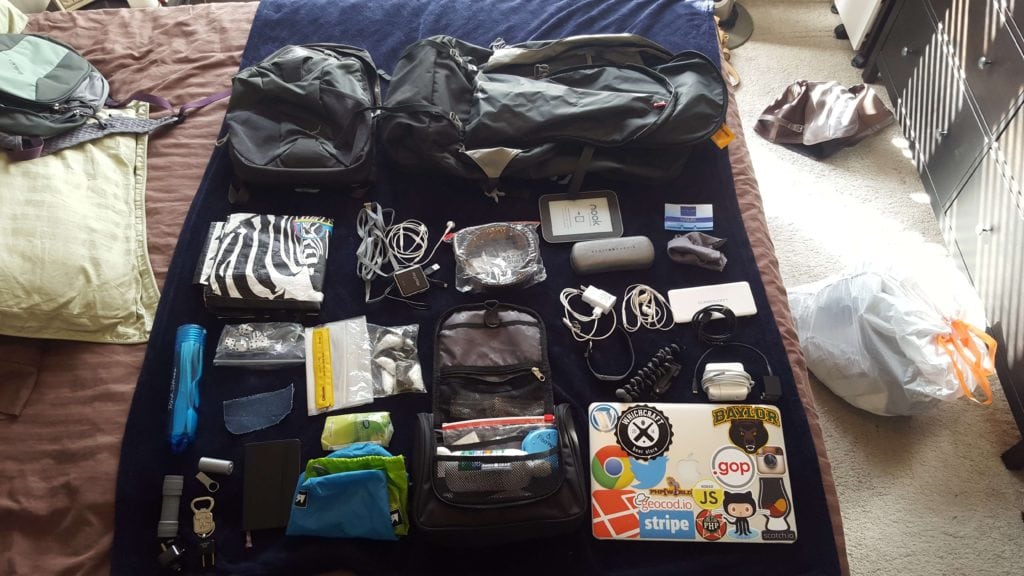
This is all of the stuff that I ended up with at the end of the trip, but I wouldn’t necessarily bring it all again. I won’t go in extreme detail, but here are the highlights:
- Electronics
- Laptop & charger
- I brought some freelance work with me, so a laptop was essential. Thankfully my Macbook Air was pretty portable and fit well in the daypack.
- Phone & charger
- E-reader (Nook)
- This isn’t really relevant, but don’t buy a Nook. They’re terrible now. Get a Kindle instead.
- Headphones (I brought a backup pair, which was silly)
- External battery pack – 10,000 mAh
- Flashlight
- Adapters
- We didn’t bring everything we needed because we were visiting a few different countries. We brought adapters for the UK, which was our first stop, and bought what we needed in other countries.
- Fitbit & charging cable
- Laptop & charger
- Organization
- Toiletries bag – SwissGear Travel Dopp Kit
- It’s really useful to have a toiletries bag that has a hook and hangs vertically. The SwissGear bag was useful but a little larger than I wanted.
- Packing cubes and packing folder
- I got these together in a kit – one folder and 2 cubes.
- The packing cubes are crucial for getting your backpack compact and organized.
- The folder, while not crucial, helps keep the wrinkles to your shirts and nice pants to a minimum. There will still be creases, but they’ll look a lot nicer than they would coming out of a cube.
- Ditty sacks – I had a couple of small ditty sacks from my hiking gear that were useful for stowing random small items.
- Waterproof pouch – I didn’t need this much, but it was nice to have for peace of mind to protect important documents and electronics while out and about.
- Toiletries bag – SwissGear Travel Dopp Kit
- Toiletries
- You probably know what you need here.
- Miscellaneous
- Grocery sack
- We picked one up at a grocery store after we arrived, and it ended up being really useful for groceries, souvenirs, snacks, and other things that didn’t end up fitting in our backpacks.
- Picnic Set
- This set of utensils from Rick Steves was a gift, and it was one of the most unexpectedly useful items we brought on the trip. The utensils are lightweight but very durable. The same can’t be said for the bottle opener, which broke upon first use. We used these very frequently when we were eating meals from the grocery store, or when eating snacks while out.
- I really liked these, but they did take up a bit of space. Next time I might opt for just bringing one of these sporks that I use for hiking.
- Bottle opener
- Dice
- We never used them. I was hoping to play some Farkle, but we we never had the energy.
- Roll of duct tape
- I never needed it, but this mini roll takes up very little space, and why wouldn’t you bring some duct tape?
- Journal
- I tried to keep a travel journal, but ended up getting behind and giving up after a little while.
- Denim patch
- Since I only brought one pair of jeans, I brought an iron-on patch just in case. Didn’t need it, but don’t regret bringing it.
- Phone tripod
- The idea behind this was to get better selfies, although we often had access to other tourists to take those pictures for us. It was pretty useful for time lapse videos.
- Laundry detergent
- This was an annoying surprise – it was very hard to buy laundry detergent there in anything smaller than a tub of pods (which I thought were less likely to leak than loose powder or liquid detergent), so I ended up somehow squeezing a small tub into my backpack for much of the trip.
- Grocery sack
What I Would Change
The items above are what I ended up with, but it’s not necessarily a perfect list. Here is what I would do differently if I were to take the same exact trip again:
- Ditched items
- I actually brought two major items which we shipped back, and which I would not bring again.
- Self-inflating travel pillow
- This sounded useful, but it took up a lot of room and didn’t get any use.
- Blazer
- I toted this around until I used it for a nice Valentine’s dinner and then I sent it back with some souvenirs.
- Self-inflating travel pillow
- I actually brought two major items which we shipped back, and which I would not bring again.
- Larger backpack
- The 55 liter bag was pretty tight on space. I had virtually no extra room in my bag for souvenirs, gifts, or any additional accessories I might have wanted to pick up. The Osprey Farpoint comes in a 70 liter capacity as well.
- Only one pair of shorts
- I brought 2 pairs of shorts, but neither of them were meant for wearing outside our hotel room. I’d reduce this to one.
- A 3rd pair of pants
- Just having the 2 pairs of pants was a bit difficult. I would probably bring along a pair of pants that would be comfortable for for long periods of walking (probably hiking pants).
- A more versatile sweater
- I liked my sweater, but I think it could have worked better as evening wear if I could have worn it with my collared shirts.
- Better button-up shirts
- I just grabbed a couple of random button-up shirts. In retrospect, I should have gotten shirts that would be less prone to wrinkles and could be easily re-worn if needed.
- A 2nd long-sleeved t-shirt
- My long-sleeved t-shirt ended up being very useful on mild days, and I would definitely bring another one next time (probably in place of one of the short-sleeved shirts).
- Lose a belt
- I’d like to find a belt that is comfortable, can be worn for weeks on end without showing any wear, and looks nice. I haven’t found it yet, so I brought two.
Conclusion
All in all, I was pretty happy with my packing list. I was surprised that I did as well with my clothing items as I did – I would make some minor changes, but overall they were pretty successful. I stayed warm in the cold, I was able to look nice at restaurants, and I didn’t stick out like a sore thumb.
If you’ve got any questions about my packing list or about the trip, don’t hesitate to ask in the comments!
{Thanks for reading! Want to know a little more about me? I’m a CPA learning how to balance a career with frequent travel while planting roots at home in Austin, TX. When I’m not exploring my home city with my husband Daniel or cuddling with our chubby orange cat Banana, I’m probably planning, packing, traveling to, or daydreaming about our next adventure. After all, my travel mug collection is never complete. If you have wanderlust too, be sure to follow me on Instagram, Pinterest, Snapchat (emilya89), or subscribe to my blog!}
Like it? Pin it!
